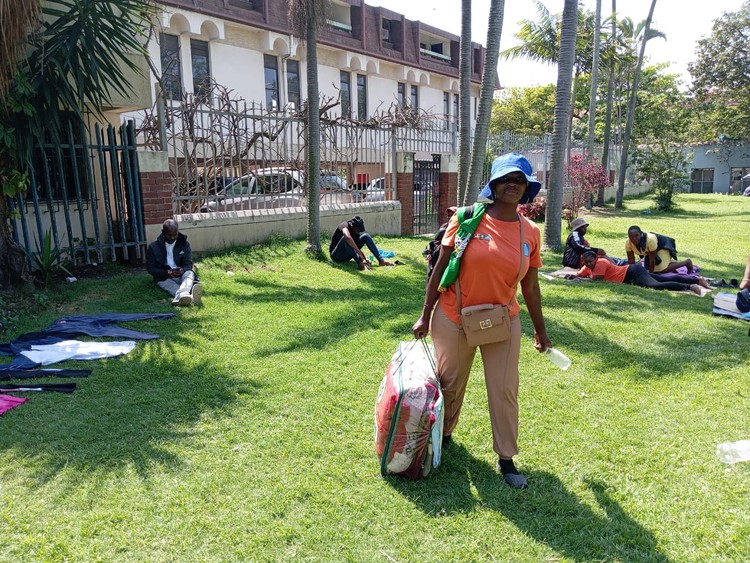The Namaquasfontein Skool Dam near Piketberg was illegally enlarged in 2017. Photo: Holland & Associates (fair use)
A farming company near Piketberg is seeking condonation for illegally enlarging the Namaquasfontein Skool Dam in 2017.
Critics fear the condonation clause in South Africa’s environmental law is, as one put it, “an expensive rubber stamp for legalising the illegal”.
The application also raises concerns about water usage in a province prone to severe water shortages.
An application to the environmental authority of the Western Cape to condone the illegal enlargement of an irrigation dam on a farm near Piketberg has raised concerns about the use and abuse of the province’s scarce water resources.
It has also turned the spotlight on official condonation of illegal environmental actions through what are known as section 24G (S24G) applications. These are made under the National Environmental Management Act (NEMA) “for the rectification of the unlawful commencement of listed activities”.
Listed activities are actions that potentially cause environmental damage or harm, such as building dams or ploughing up virgin veld, and for which pre-activity environmental authorisations are required.
Concerns highlighted by the S24G process include the large number of unauthorised and illegal dams built on agricultural properties in the province in recent years, and the cumulative impact of this substantially increased water impoundment on the ecological functioning of rivers, streams, vleis and wetlands.
Critics also warn of “a worrying trend” that illegal dams are possibly being cynically constructed by landowners who then apply post facto for condonation, knowing that fines for these environmental transgressions may well be substantially less than potential income from additional irrigation options.
Crucially, this warning comes from a section within the provincial Department of Environmental Affairs and Development Planning (DEADP), which is the Western Cape NEMA authority and decides on S24G applications.
DEADP is currently assessing 11 applications relating to the illegal capture and storage of water. Three administrative fines have already been issued.
During the past five years, the department has issued 21 environmental authorisations for S24G applications. No applications were refused during this period.
In terms of NEMA, a S24G applicant must pay an administrative fine, which can be up to R10-million, before the competent authority can consider the issue. Fines are determined by a formula relating to the type of activity involved and its impact on the environment.
Both the fine and the final decision are subject to appeal.
Illegally enlarged dam
One of the current condonation applications was submitted by Piekenierskloof Vrugte (Pty) Ltd, a farming company that leases Portion 4 of Farm 76 Namaquasfontein in the Moutonshoek valley, 22km northwest of Piketberg towards Redelinghuys.
The company is seeking rectification for illegally enlarging the Namaquasfontein Skool Dam in 2017, from its original storage capacity of about 1,000 cubic metres to 47,000m3, with an embankment wall 6.2 metres high.
It also wants condonation of a 1.8km pipeline that includes two minor river crossings, and other water infrastructure at the Krom Antonies River which flows through the Namaquasfontein property.
Its application includes phase 2 of this project: the proposed further enlargement of the dam to a total storage capacity of 200,000m3 behind an 11.5 metre high embankment wall, and a river crossing with an upgraded slab and pipe culverts.
The Krom-Antonies River is one of four rivers feeding Verlorenvlei which is a proclaimed wetland site of international significance and an Important Bird and Biodiversity Area (IBA), as defined by BirdLife International. It is also a crucial water source for West Coast communities.
Verlorenvlei was profoundly impacted by severe drought in recent years and effectively dried up completely. Despite this year’s good rainfall, the vlei remains severely damaged with highly toxic acidic levels.
Consultants favourable report
The S24G application, prepared for the applicant by Tokai-based environmental consultants Holland & Associates, strongly emphasises that the illegal dam should be considered as an “off-channel dam” that is not directly impounding the Krom Antonies River. They point out that the original dam was located within a seep area, and was filled from this seep as well as from diversions from two small adjacent tributaries of the Krom Antonies River.
On responses from 34 Interested and Affected Parties (IAAPs) to the application as part of the statutory public participation process, the consultants state: “The significance of the impact on downstream flow and aquatic ecosystems (on the lower Krom Antonies and on the Verlorenvlei) is medium to low without mitigation, and low with mitigation, due to the fact that the water used to fill the off-channel dam is from an existing water entitlement [water right] and the water is rather taken from the system in winter when there is surplus flow in the river.”
They state the main purpose of the dam project is to increase storage for the existing water right in order to achieve sustainability for farming activities that include citrus fruit production. The completed dam is therefore an “assurance of supply” project.
They conclude: “The construction of the Namaquasfontein Skool Dam does not have any unacceptable negative impacts on the biophysical and socio-economic environments, and is supported by the freshwater, botanical and heritage specialists.”
All applications for environmental authority for a proposed activity require the proper consideration of alternatives – including a so-called “No Go” alternative. In this case, a “No Go” decision would require decommissioning the illegally constructed dam and rehabilitating the area.
The consultants argue that that while such a “No Go” alternative would potentially have the least impact on the aquatic ecosystems, it would lose some of the positive opportunities and socio-economic benefits associated with the dam.
They repeatedly reject the “No Go” option for the Namaquasfontein dam, claiming that this would be “an irrational outcome in the circumstances”. Although agreeing that unauthorised abstractions and instream dams should “certainly not be permitted and need to be addressed”, they say their client is “following due process in this regard”.
Worrying trend
But the consultants’ arguments, claims and conclusions don’t wash with the vast majority of the 34 IAAPs – including local authorities, government departments, conservation groups and individuals – who responded to the application.
In their consolidated comment, two sections of DEADP – the Directorate for Pollution and Chemicals Management and the Directorate for Biodiversity and Coastal Management – point to the Verlorenvlei Hydrological Impact Review of November 2021 by groundwater specialist consultancy Umvoto Africa, which highlighted an increase in surface water use in the relevant Verlorenvlei catchments. They attribute this to expanded and intensified commercial agricultural practices within these catchments.
“The increased agricultural needs put a further strain on the availability of water needed to support the downstream Verlorenvlei estuary. The proposed increase in storage capacity of the [Namaquasfontein] dam will put further pressure on the Verlorenvlei system,” the directorates comment.
They also point out that the Umvoto review found “numerous” unregistered dams scattered within the upper reaches of the Verlorenvlei catchment but only a “few” that were recorded in South Africa’s national register of water use: the Water Use Authorization & Registration Management System of 2008.
“This discrepancy suggests that widespread unregulated water use exists in the upper catchment, cutting off vital streamflow into the Krom Antonies and Verlorenvlei system.”
Rejecting the application in its current form, the Directorate for Pollution and Chemicals Management comments: “The localised impact of the unlawful dam enlargement and associated infrastructure may have been assessed in the S24G application to be potentially low; however, this is a narrow view of the potential impacts and largely disregards the cumulative impact on the Verlorenvlei system, which would have far-reaching consequences.”
The Directorate: Biodiversity and Coastal Management concludes: “This application must be considered in the context of the worrying trend of landowners within these catchments allegedly factoring in the legal risks and the costs of S24G applications, including the payment of fines, and thus expanding water storage dams and irrigated agriculture and ploughing of virgin land unlawfully. The competent authority must have a view to the message that rectification in this context sends out to the regulated community.”
“This application has not been considered in the context of the entire Verlorenvlei system being [in] crisis and as such [the directorate] does not support this application or the proposed enlargement of the Namaquasfontein Skool Dam.”
The environmental management sections of the West Coast District Municipality, Bergrivier Municipality and the Cederberg Municipality all call for the “No Go” alternative to be applied, as does conservation authority CapeNature and conservation group BirdLife SA.
In its response, the national Department of Water and Sanitation states that the lower Krom Antonies River and Verlorenvlei River are “under severe pressure” and that the applicant’s motivation for increased water storage is “not sufficient”.
In a strongly worded submission, vice chairperson of the Friends of Verlorenvlei conservation group Nick Taylor also calls for the “No Go” option and slams the S24G process as “outmoded”, “disgraceful” and “no longer workable” in current conditions.
“The public perception and the reality is that S24G applications are simply a process by which you commit a crime and then plead ignorance or extenuating circumstances, and all is forgiven … S24G cases are an expensive rubber stamp for legalising the illegal.”
The Namaquasfontein application is a “watershed”, Taylor argues. “In my opinion, both the Western Cape and national governments are faced with a dilemma. They can either accept the illegal activities as a fait accompli and issue a fine, or use the opportunity to treat this S24G application as a test case and rule for the ‘No-Go’ option. We believe the ‘No Go’ option is the only option.”
Wouter Kriel, spokesperson for DEADP MEC Anton Bredell, told GroundUp last week that Piekenierskloof Vrugte’s application was still being considered and that no administrative fine had yet been issued.






